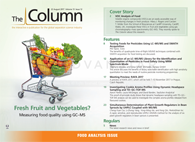Janssen Awarded Grant for VUV Research
VUV Analytics has announced Hans-Gerd Janssen and his laboratory at the University of Amsterdam, The Netherlands, as the recipient of their academic grant.

VUV Analytics (Cedar Park, Texas, USA) has announced Hans-Gerd Janssen and his laboratory at the University of Amsterdam, The Netherlands, as the recipient of their academic grant. Janssen’s research will focus on the development of novel methods using vacuum ultraviolet (VUV) detection.
“We are excited to have been selected by VUV Analytics as the recipient of their academic grant programme and feel that we can provide new insight into food and cosmetics product analysis using VUV spectroscopy,” said Janssen.
“VUV Analytics is excited to award the University of Amsterdam with our detector to help continue the groundbreaking advancements taking place in their labs,”
said Sean Jameson, vice president of Business Development
at VUV Analytics.
Janssen is a Professor at the University of Amsterdam and Science Leader at Unilever Research Vlaardingen, The Netherlands. His research is focused on the development of novel methods for obtaining highly detailed compositional information on complex samples.
For more information please visit www.vuvanalytics.com

Measuring Vitamin K1 Concentrations in Dogs with Chronic Enteropathy Using LC–MS/MS
May 14th 2025A joint study between the University of Tennessee (Knoxville, Tennessee) and the University of Pennsylvania School of Veterinary Medicine (Philadelphia, Pennsylvania) compared directly measured vitamin K1 (vitK1) concentrations in healthy dogs and dogs with chronic enteropathy (CE) using liquid chromatography tandem mass spectrometry (LC–MS/MS); they also investigated whether supplementation of vitK1 in dogs with CE would significantly increase vitK1 concentrations.
HPLC 2025 Preview: Fundamentally Speaking (Part 2)
May 14th 2025Michael Lämmerhofer from the Institute of Pharmaceutical Sciences, University of Tübingen, Germany, spoke to JFK Huber Lecture Award winner of 2024 Torgny Fornstedt, professor in analytical chemistry and leader of the Fundamental Separation Science Group, Karlstad University, Sweden, about his pioneering work in high performance liquid chromatography (HPLC) with a focus on fundamentals, ion-pair chromatography, and oligonucleotide applications.

.png&w=3840&q=75)

.png&w=3840&q=75)



.png&w=3840&q=75)



.png&w=3840&q=75)


![IMG_4773[1].jpg IMG_4773[1].jpg](/_next/image?url=https%3A%2F%2Fcdn.sanity.io%2Fimages%2F0vv8moc6%2Fchroma%2F6db719ea80519dad8e948ad595b96c3fa3731826-200x207.jpg%3Ffit%3Dcrop%26auto%3Dformat&w=3840&q=75)










